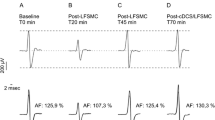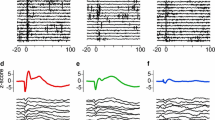Summary
The author stimulated the paramedian cerebellar lobe in cats by direct current (anode or cathode). He observed 2 types of reactions of antagonist muscles to the stimulation of the corresponding motor area of the cerebral hemispheres: 1) a change in the intensity of the coordinating relations mainly due to the extensor, or 2) establishment of new antagonistic relations, mainly as a result of the altered reactions of the flexor. There was also a conversion from one type of change to another. The cerebellum intensifies the flexor reactions characteristic of voluntary movements by depressing extension.
Similar content being viewed by others
Literature Cited
A. M. Aleksanian, Cerebellar Function, Moscow (1948). [In Russian].
A. A. Guminskii, The Effect of the Cerebellum on the Coordination of Spinal Reflexes, Dissertation (Moscow, 1951). [In Russian].
R. S. Mnukhina, The Effect of Extirpation and Stimulation of the Cerebellum on Spinal Reflexes, Dissertation (1945). [In Russian].
R. S. Mnukhina, Fiziol. Zhur. 37, No. 1, 52–58 (1951).
N. F. Popov, In book: Collected Works of the Institute of Higher Nervous Activity, 1, 93–139 and 140–148 (1929). [In Russian].
E. K. Sepp, The History of Development of the Nervous System in Vertebrates, Moscow (1949). [In Russian].
C. Sherrington, The Integrative Activity of the Nervous System (1935). [Russian translation].
R. Brun, Das Kleinhirn. Zurich (1927).
S. Clark, J. Word, J. Neurophysiol. v. 15, 221–234 (1952).
O. Foerster and H. Altenburger, Dtsch. Ztschr. Nervenh. Bd. 135, S. 277–288 (1935).
J. Fulton, E. Liddell, and D. M. Rioch, Arch. Neurol. a. Psychiat.. v. 28, 542–570 (1932).
K. Goldstein, In book: A. Berthe. Handbuch der normalen u. patholog. Physiologie, Berlin, Bd. 10, S. 222–317 (1927).
F. Nulsen, S. Black and C. Drake, Feder. Proc. v. 7, 86 (1948).
R. Snider and E. Eldred, J. Neurophysiol. v. 15, 27–40 (1952).
R. Snider, W. S. McCulloch and H. Magoun, J. Neurophysiol. v. 12, No. 5, 325–335 (1949).
R. Snider, W. S. McCulloch and H. Magoun, Feder. Proc. v. 6, 207 (1947).
R. Snider and H. Magoun, J. Neurophysiol. v. 12, 335–347 (1949).
A. Stowell and R. Snider, Feder. Proc. v. 1, 84 (1942).
J. Spragul and W. Chambers, J. Neurophysiol. v. 16, 451–463 (1953).
F. Tilney and F. Pike, Arch. Neurol. a. Psychiat. v. 13, 289–334 (1925).
C. Terzuolo and H. Terzian, J. Neurophysiol. v. 16, 551–561 (1953).
Author information
Authors and Affiliations
Rights and permissions
About this article
Cite this article
Gil'man, I.M. The role of the cerebellum in the performance of motor activity. Bull Exp Biol Med 46, 1285–1289 (1958). https://doi.org/10.1007/BF00845166
Received:
Issue Date:
DOI: https://doi.org/10.1007/BF00845166




